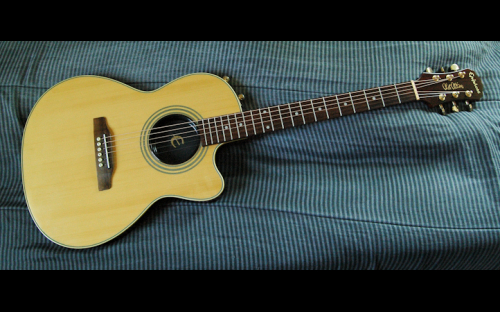Ninja00151
Junior Member
- Messages
- 26
I leveled the frets on one of my guitars yesterday, and decided to do a little tone and playability shootout experiment.
Once fret leveled, the guitar was stringed up and neck was set dead flat. Saddles were raised so that string action is 5/64"th or 2mm at the 12th fret, without a capo (medium-low action).
I proceeded to play every note, fret by fret along the fretboard. I noticed an interesting observation. A plucked note will be initially clean on the first 1-5ish frets, but the sustained note will then "crash" into the frets somewhere, resulting in a slight buzzing. I then played a few chords to try and listen for the fret crash. Not really noticable.
Neck relief was increased incrementally, with the same test conducted. As neck relief increased, fret crash decreased. Now there is a little problem- as neck relief increases for a given saddle height, the action increases.
So I worked my way incrementally up to the standard .01" neck relief, and then lowered the saddles so that action was again 5/64th. I was shocked at how much less fret crash there was compared to a dead flat neck with the same relief. I honestly thought it was placebo effect the first time, so went through the huge ordeal of trying it a few times. Even though you couldn't really hear the fret crash with chords on a dead-flat neck, the neck relief setup sounded a TON better.
I came to the conclusion that Chords acoustically ring out substantially better with .01" neck relief vs a dead flat neck at the same 12th fret action. String crash on sustained notes was eliminated on every string but the low E, with only a little remaining on the low E. Raising the low E to 6/64th did not eliminate fret crash.
Conclusion: Sustained notes or chords experience "fret crash" on the first few frets when the neck is set too flat. Increasing relief eliminates or substantially reduces this fret crash, and is acoustically audible as an improvement in tone with chords in the same fret area. The industry standard .010" neck relief is recommended over flatter settings, even with perfectly leveled frets.
So my question goes out to you guys, what's your preferred string action? Do you measure it, or eyeball it? Personally, I use a FretGuru2... probably the best guitar tool I've ever bought. No affiliation :icon_thumright:
Once fret leveled, the guitar was stringed up and neck was set dead flat. Saddles were raised so that string action is 5/64"th or 2mm at the 12th fret, without a capo (medium-low action).
I proceeded to play every note, fret by fret along the fretboard. I noticed an interesting observation. A plucked note will be initially clean on the first 1-5ish frets, but the sustained note will then "crash" into the frets somewhere, resulting in a slight buzzing. I then played a few chords to try and listen for the fret crash. Not really noticable.
Neck relief was increased incrementally, with the same test conducted. As neck relief increased, fret crash decreased. Now there is a little problem- as neck relief increases for a given saddle height, the action increases.
So I worked my way incrementally up to the standard .01" neck relief, and then lowered the saddles so that action was again 5/64th. I was shocked at how much less fret crash there was compared to a dead flat neck with the same relief. I honestly thought it was placebo effect the first time, so went through the huge ordeal of trying it a few times. Even though you couldn't really hear the fret crash with chords on a dead-flat neck, the neck relief setup sounded a TON better.
I came to the conclusion that Chords acoustically ring out substantially better with .01" neck relief vs a dead flat neck at the same 12th fret action. String crash on sustained notes was eliminated on every string but the low E, with only a little remaining on the low E. Raising the low E to 6/64th did not eliminate fret crash.
Conclusion: Sustained notes or chords experience "fret crash" on the first few frets when the neck is set too flat. Increasing relief eliminates or substantially reduces this fret crash, and is acoustically audible as an improvement in tone with chords in the same fret area. The industry standard .010" neck relief is recommended over flatter settings, even with perfectly leveled frets.
So my question goes out to you guys, what's your preferred string action? Do you measure it, or eyeball it? Personally, I use a FretGuru2... probably the best guitar tool I've ever bought. No affiliation :icon_thumright:


